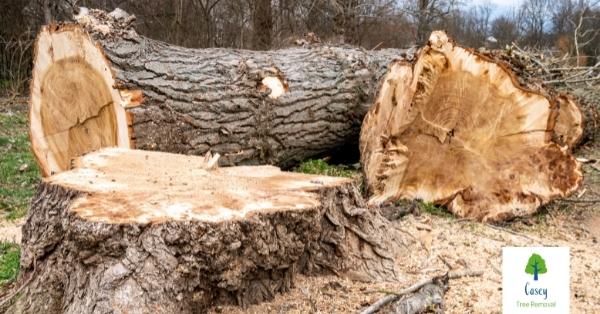Tree felling is one of the most dangerous tasks a tree surgeon has to undertake and there are many steps and precautions that need to be taken into consideration to successfully and safely cut down a tree.
Straight Felling: The Basics
As with all trees that are cut down, the true results can be found at the stump and the most important is the hinge, especially the length and width of the hinge, as this controls the direction of the fall.
To establish a hinge you first need to create a face notch and then a back cut into the hinge position. All of this works on the plan you put in place to get your results.
Straight Felling: Safety and Planning
Safety and planning are two of the most important aspects when cutting down a tree.
There are many things to consider and they must be established first before commencing with any cutting.
Step 1: Hazards and Obstacles
Firstly you should look for any hazards or obstacles on the tree you plan to place on the ground.
Are there any vines or deadwood on the tree? If so they should be removed.
You should always observe your surrounding area to make sure there are no obstacles such as houses, trees or power lines in the way.
Tip: You can use a marker flag staked into the ground as a target reference of the direction you want it to go in.
Step 2: Lean of the Tree
Establishing the lean of the tree in relation to the position you want to place it is crucial.
The tree has lean to the left side of the operator’s position. To take that measurement you should start from the farthest limb of the crown to the left and right, half that position and plum into the ground.
After the side lean has been established the next thing to work out is if the lean is more to the front or back of the tree.
From a position of 90° degrees from the side, you must check to see if there is lean into the direction of the target or away from it.
You can use the exact same method for establishing the lean from the target. You take the farthest limbs back and forward, half that distance and plum line into the ground.
Step 3: Plan a Retreat Path
Planning your escape route is the next important step and should never be overlooked!
You need to plan a retreat path for when the tree starts to move but also make sure there are no trip hazards, so you can make a hasty retreat without falling.
You want to retreat from the away from lean side for a minimum of 15 feet.
Step 4: Establish a Hinge and Face Notch
You now need to take a look at establishing the hinge and to do this you need to have a face notch to allow it to work.
The face notch should have a 70° degrees open and it needs to be the length of the notch, roughly 80% percent of the diameter of the tree.
To cut out a face notch you need to have a cut coming in from the top and the bottom to establish a 70° degree open, which should be the minimum.
Once the notch has been cut out at 70° degree or more, we can check to see if the angles are correct.
You want your hinge to be around 10% percent of the diameter of the tree, which is about an inch to an inch and a quarter behind the notch.
Step 5: Establish a Back Cut
In this step we need to do a back cut to establish the hinge. The back cut should come in at the corner of the face notch or sometimes a little higher.
As you can see in the video, the information suggests the weight of the tree is coming back, so the use of wedges in the back of the tree or pulling rope is a good idea in this instance.
For this tree and situation, Tim demonstrates the plunge cut, also known as a bore cut, where he saws through the tree, establishing a hinge and finally placing a wedge and releasing the back.
Reaction Forces Safety Tip
Before working with a chainsaw, especially in utilising the bar for a plunge or bore cut, you as an operator need to understand the reactive forces.
- Cutting on top of the bar gives you a push back reaction
- Cutting on the bottom pulls the chainsaw away from the operator
- Any contact or pinch on the tip of the chainsaw causes rotational kickback
If you have to use the tip of the saw, the best place to start is the lower corner pulling chain and to make sure you understand these reactive forces.
Step 6: Wedge and Final Cut
For safety, you should place a wedge in the back to hold the weight of the tree. This will help to support the tree, ensuring it does not sit back on the saw.
You can then proceed with the final cut and clip off the back of the strap, drive the wedge in and follow your retreat path.
If all steps have been followed correctly, the tree should hopefully land within its target.
Step 7: Analyse Your Results
It is important to analyse your results to gain more experience and get a better understanding of how felling works.
The shot close by utilising the target stake, but the real results come down to 3 tree cutting concepts.
- Notch
- Hinge
- Back Cut
It is also important to understand the release and pivot point, all while executing your escape plan.
If you were to have a 45° degree face notch, the tree would move at about half way and force the hinge to give-up, which can cause an uncontrolled fall.
If you have a 70° to 90° degrees notch, this allows the tree to go all the way over and down to the ground before the hinge is stressed.
This will allow you to get things at a good pace, better steer the direction of the fall and also gives us more reaction time to execute your escape plan.
Casey Tree Removal – All Tree Services including Tree Cutting, Tree mulching, Tree Trimming, Stump Grinding, Tree Pruning, Stump Removal, Emergency Tree Removal Experts In Melbourne!
Click here to read more articles regarding tree removal & related services.
If you are in Narre Warren North and looking for Casey Tree Removal, below is the best way to visit us.


Recent Comments